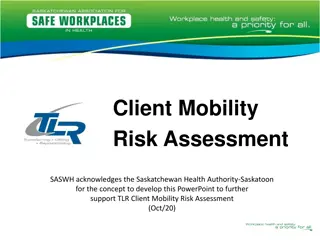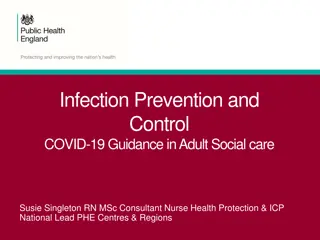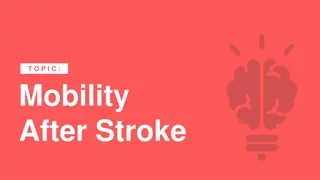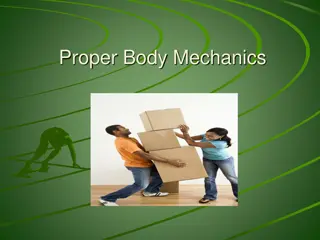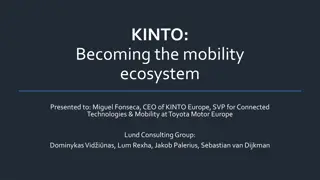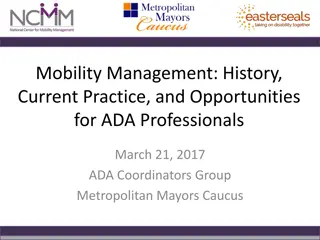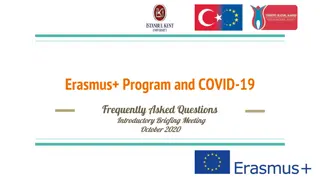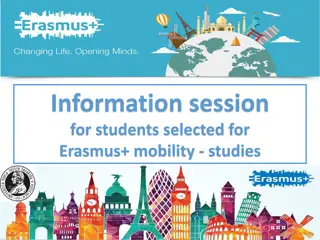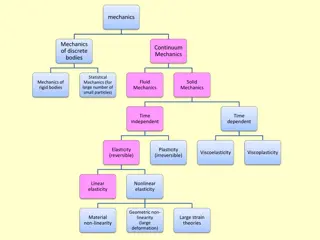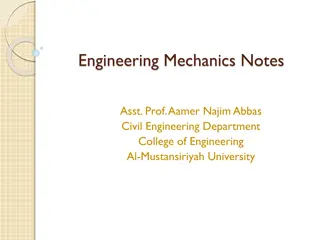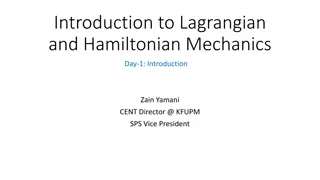Practical Guidance for Care Partners: Maintaining Healthy Body Mechanics and Mobility
This presentation offers practical advice for care partners on how to maintain healthy body mechanics, promote safe transfer and mobility techniques, and use mobility equipment effectively. It emphasizes the importance of being a healthy caregiver, staying strong and fit through appropriate exercise programs, and reducing physical strain to prevent musculoskeletal injuries. By practicing good body mechanics and focusing on individual needs, care partners can provide better care while safeguarding their own well-being.
Download Presentation

Please find below an Image/Link to download the presentation.
The content on the website is provided AS IS for your information and personal use only. It may not be sold, licensed, or shared on other websites without obtaining consent from the author. Download presentation by click this link. If you encounter any issues during the download, it is possible that the publisher has removed the file from their server.
E N D
Presentation Transcript
Practical Guidance for Care Partners Ruben Pagkatipunan Jr., PT, DPT, OCS Department of Rehabilitation, Johns Hopkins Bayview Medical Center Baltimore, Maryland, USA Malin Regardt PhD, OT Karolinska University Hospital Stockholm, Sweden
Disclaimer The health information provided in this presentation is provided for general informational and educational purposes only, and is not a substitute for professional health advice. Consult your physicians, physical therapists, and occupational therapists regarding your individual needs with regards to mobility. We do not endorse or recommend any particular products mentioned in this presentation. We do not have any financial interest in any of the products or with any of the vendors.
Outline How to be a healthy caregiver Proper body mechanics Safe Transfer and Mobility Techniques Mobility equipment
Be a Healthy Caregiver Be strong and stay fit Eat well Keep up your emotional energy Take care of your back
Be strong Have your own muscle strengthening program Easy to do at home Specific muscles (abdominals, gluteals, thigh, shoulder/upper arm) Start with low-intensity, high-reps with gradual progression Regularly Don't forget to stretch! Focus on the core muscle group
Stay fit Aerobic training program Fun, enjoyable How long? At least 30 minutes Several times a week How hard? Moderate Use "Talk test to monitor exercise intensity
Physical Strain on Caregivers ? Studies have shown caregivers are at increased risk of musculoskeletal symptoms and injury Prevalence of LBP was significantly higher among caregivers (58%) compared with age- and BMI- matched controls (27.6%) (Bardak, Erhan, & Gunduz, Journal of Rehabilitation Medicine, 2012) ? Transfers, lifts, and patient repositioning are associated with musculoskeletal injury (Daragh et al., Journal of Applied Gerontology, 2015) ? Most common causes of back injury Lifting a heavy object incorrectly Twisting the spine while lifting Sudden, jerky movements while lifting Poor posture or body mechanics over time
Practice Good Body Mechanics Good body mechanics is the correct positioning of the body to maintain the natural spinal curves (neutral spine) during lifting, bending, moving and performing activities of daily living Maintain neutral spine position Why learn correct body mechanics? Ensure safety of caregiver and patient Reduce stress and strain to the muscles, joints, and soft tissues, preventing injury Conserve energy
Principles of Good Lifting Technique Maintain a wide base of support Keep good posture (neutral spine), bend with knees, not with your back Use the stronger leg muscles to do the lifting Keep the load close to your body Avoid twisting and turning Clear the pathway Plan the sequence of events Can you manage by yourself? Know your capabilities
Safe Transfer and Mobility Techniques Bed mobility Transfers Wheelchair repositioning Getting up from the floor Disclaimer: The transfer/mobility techniques shown may need to be modified for specific patient diagnoses
Transfer techniques Before you transfer the person... Prepare the environment Get equipment ready Plan the movement Prepare the patient
Transfer techniques Stand pivot transfer Squat pivot transfer Sliding board transfer
Squat Pivot Transfer 1-person assist 2-person assist
Repositioning a Person in the Chair and Wheelchair Option 1: With the help of a person
Repositioning a Person in the Chair and Wheelchair Option 2: With help of one person
Repositioning a Person in the Chair and Wheelchair Option 3: With the help of two people
Getting Up From the Floor If the person is unconscious or injured, call 911 for emergency medical assistance Only attempt to help the person if you feel that both of you are able to safely work together If patient is not hurt and is able to move, you may assist with getting up from the floor Forward method using knees Backward method using arms Hip Hike
Transfer and Mobility Equipment Chair booster Lifting seat Step ladder Beasy board Hoyer lift Extra-thick seat cushion
Transfer and Mobility Equipment GentleBoost Uplift Assist Commode and Shower Chair Mangar ELK Emergency Lifting Cushion 30
Transfer and Mobility Equipment Rifton TRAM
Thank you! 32
Reference Bardak, A., Erhan, B., & G nd z, B. (2012). Low back pain among caregivers of spinal cord injured patients. Journal of Rehabilitation Medicine, 44(10), 858-861. doi:10.2340/16501977-1043 Lockette, K. F. (2Lockette, K. F. (2011). A caregivers complete guide for safe mobility and independence in the home. Minneapolis, MN: Two Harbors Press.011). A caregivers complete guide for safe mobility and independence in the home SolutionsBenefits. (n.d.). November 09 Monthly Safety Spotlight November 09 Safety Discussion Topics, horizontal format Get to Know Your Back Lifting Safety Checklist Maintaining. - ppt download. Retrieved from https://slideplayer.com/slide/4920136/
Reference List for Images/Videos Slide 6 (people exercising with elastic bands): https://thecaregiverspace.org/how-to-encourage-the-elderly-to-exercise/ Slide 6 (seniors exercising with a ball and a kettle ball): https://www.verywellfit.com/chair-exercises-for-seniors-4161267 Slide 6 (people on gym ball exercising with weights): https://www.aarp.org/auto/driver-safety/info-2013/exercise-for-safety.html Slide 6(people doing plank): https://blog.cheapism.com/exercises-for-seniors/ Slide 7 (pool exercises for seniors): https://www.upliftingmobility.com/pool-exercises/ Slide 7 (people walking together): https://www.verywellhealth.com/the-benefits-of-walking-for-people-with-copd-914997 Slide 7 (people in aerobic class): https://www.tribuneindia.com/news/health/aerobic-exercise-may-ward-off-memory-decline-in-elderly/314148.html Slide 7 (people in spinning class): https://www.freepik.com/premium-photo/people-working-out-spinning-class-while-gesturing-thumbs-up_1833569.htm Slide 8 (risk of injury picture): http://www.springvillechiropractic.com/our-services/lower-back-pain Slide 9 (picture of spine ligament and a person bending over): https://www.spineuniverse.com/wellness/ergonomics/body-mechanics-your-spine-tips-1-3 Slide 9 (picture of the spine): https://en.wikipedia.org/wiki/Neutral_spine Slide 9 (person lifting box): https://myhealth.alberta.ca/Health/pages/conditions.aspx?hwid=hw206944 Slide 9 (person lifting neutral spine position and non-neutral spine): https://www.reddit.com/r/Fitness/comments/3ky5fg/my_road_to_elite_level_powerlifter_from_235lbs_to Slide 10 (proper lifting techniques): https://www.braceability.com/blogs/articles/7-proper-heavy-lifting-techniques Slide 10 ( transfer logo): https://safepatienthandling.us/manual-patient-transfers/ Slide 18 (stand pivot transfer): https://www.drugs.com/cg/how-to-transfer-a-person-safely-ambulatory-care.html Slide 19: (squat pivot transfer 1-person assist and 2-person assist) https://www.mrswivel.com/patient-transfers/squat-pivot-transfer/ Slide 20 (sliding board transfer): http://www.spinalcordessentials.ca/handouts/lateral-transfer/ Slide 21-23 (wheelchair and chair repositioning): https://www.vardhandboken.se/arbetssatt-och-ansvar/arbetsteknik-och-forflyttningskunskap/oversikt/ Slide 25(getting up from floor using knees): https://www.stayonyourfeet.com.au/over60/what-if-i-do-fall/get-up-off-the-floor/ Slide 26(Helping Someone Up after a Fall): https://www.youtube.com/watch?v=10jR0zjl19Y Slide 27 (a person getting from floor using ResQUp fall recovery aid): https://www.activeforever.com/resqup-floor-recovery-mobility-aid Slide 27(getting up from floor using arms): https://www.stayonyourfeet.com.au/over60/what-if-i-do-fall/get-up-off-the-floor/ Slide 28(how to get up from the floor macgyver style, from youtube): https://www.youtube.com/watch?v=4ETgQD8QhZs
Reference List for Images/Videos Slide 29 (seat cushion): https://www.allegromedical.com/cushions-covers-backs-c544/deluxe-seat-lift-cushion- p555966.html?CS_003=9164468&CS_010=ff808181178387c301179dcff8be031a&gclid=Cj0KCQjwkK_qBRD8ARIsAOte ukAzVou-wF6PGOs_AUp325xXLljdY3kmqPa1Uc8OUZb-0PDp_GoIZIEaAjC9EALw_wcB#1179-DCFF8F8 Slide 29 (hoyer lift): https://www.amicamedicalsupply.com/blog/top-5-hoyer-lifts-for-home-use/ Slide 29 (seat assist): https://www.medical-supplies-equipment-company.com/homehealth/product/lifting- cushion_14209.html Slide 29 (beasy board): https://www.amazon.com/Beasy-Board-Transfer-System-BeasyTrans/dp/B01BL43XKW Slide 29 (chair booster): https://www.target.com/p/kaboost-portable-chair-booster-natural/-/A-52783155/ Slide 30 (Mangar ELK Emergency Lifting Cushion) : https://www.lightningmobility.com.au/products/patient- handling/mangar-elk-floor-lift Slide 30(GentleBoost Uplift Assist Commode and Shower Chair): https://www.amazon.com/GentleBoost-Self- Powered-Freestanding-Platinum-Healthcare/dp/B01LXM50T1 Slide 31(Rifton Tram picture): https://www.adaptivemall.com/riftontram.html?gclid=EAIaIQobChMI4fHLzMa94wIVDxgMCh0-- A9EEAQYASABEgLDdfD_BwE Slide 31(patient being transferred out of chair using rifton tram): https://www.rifton.com/adaptive-mobility- blog/blog-posts/2017/october/workers-compensation-patient-transfers-tram Slide 31 (patient walking with rifton tram with healthcare professional): https://www.rifton.com/adaptive- mobility-blog/blog-posts/2014/september/stand-pivot-transfer-tram Slide 31(patient being transferred out of w/c using Rifton TRAM):https://www.dailycareinc.com/shop/product/rifton-tram-lift-gait-trainer-sit-to-stand-lift-rental



